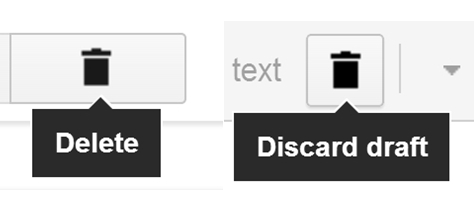The problem I’m about to write about has been persisting for quite a while and I thought Google would have fixed it by now. Alas, no such luck, thus far.
In a nutshell, we have been aware of the extreme importance of consistent mapping to learn automatic, efficient and error-free behavior ever since Schneider & Shiffrin (1977).
Briefly put – although this differs from the particular experimental design of Shiffrin & Schneider – it is crucially important that the same symbol consistently has the same meaning and is not sometimes associated with other meanings.
And this is the problem with the current way Gmail uses the trashcan symbol. It can at the same time be used to delete an entire thread (possibly consisting of hundreds of individual emails) as well as to discard a recent – and unsent – individual draft of a message.

"Delete" refers to moving the entire thread - which could contain hundreds of messages - into the trash. "Discard draft" refers to one - as of yet unsent - message.
This is a concern because while the mouseover disambiguates the symbol, users do learn an automatic mapping (e.g. assuming that the trashcan discards a draft) so the mouseover never comes up in efficient mass-email handling. This leaves the possibility for users to accidentally delete entire email threads when they simply want to discard a draft. I know it happened to me, repeatedly.
This is a particular concern for Gmail because its whole concept rests upon the notion that one should never have to delete an email. However, because the system allows for accidental deletion, the integrity of the entire corpus is at risk.
Google is usually good about user interface design, but not in this case. Sadly, the ambiguity affects a critical function that can’t be undone after 30 days (and probably won’t be in time if it happened accidentally).
The good news is that this ought to be an easy fix. And should only be remembered as a cautionary tale.
